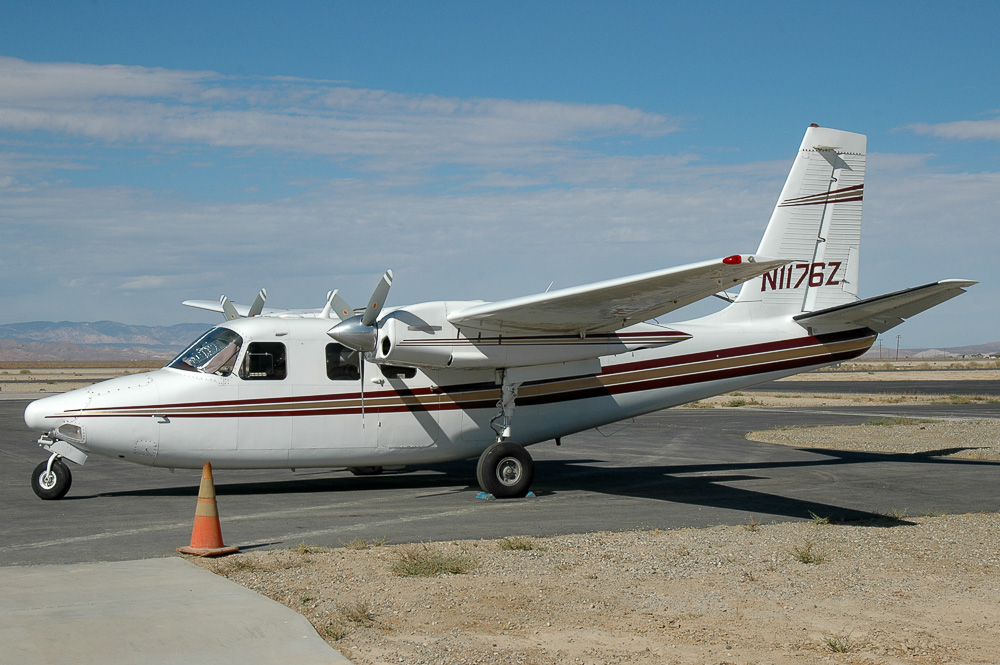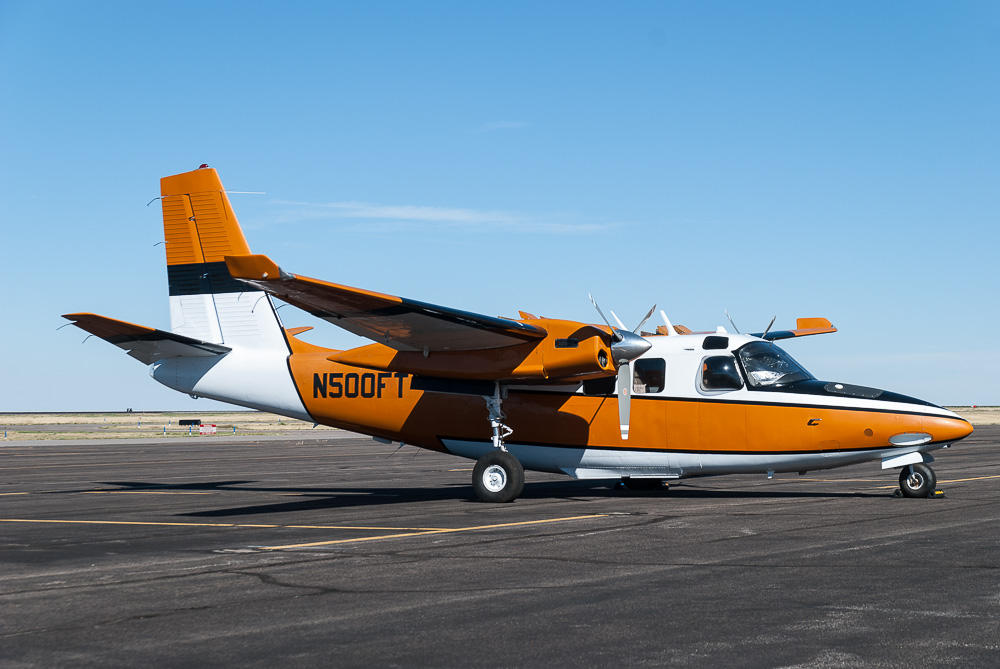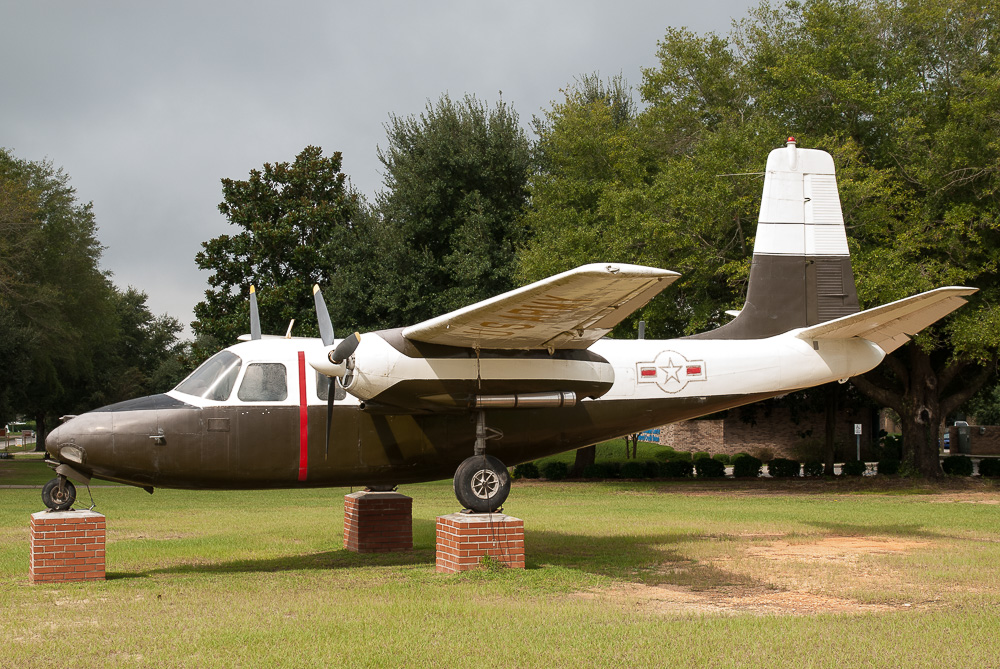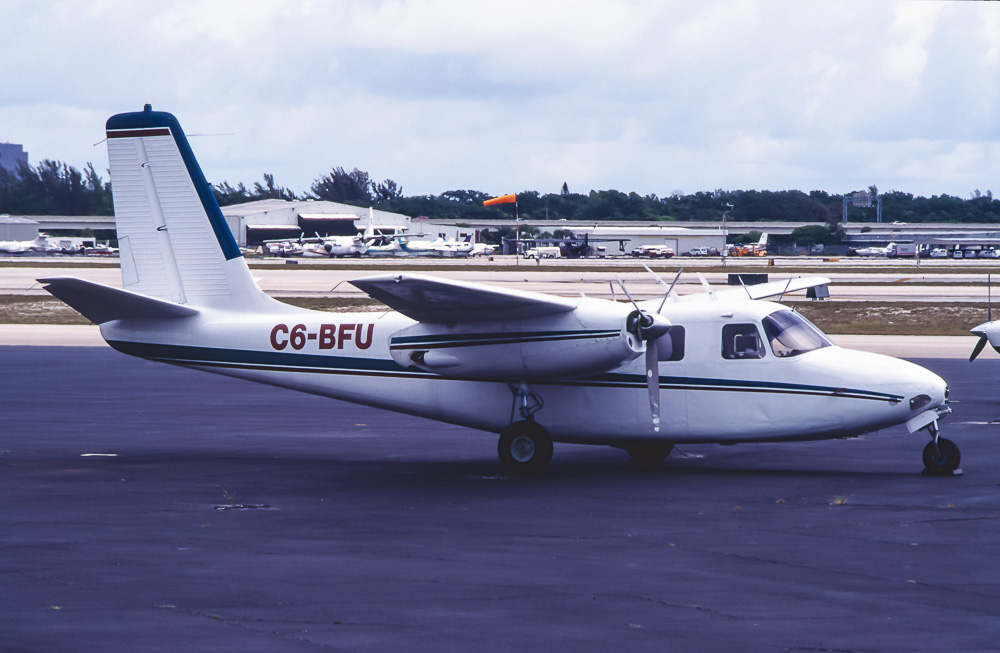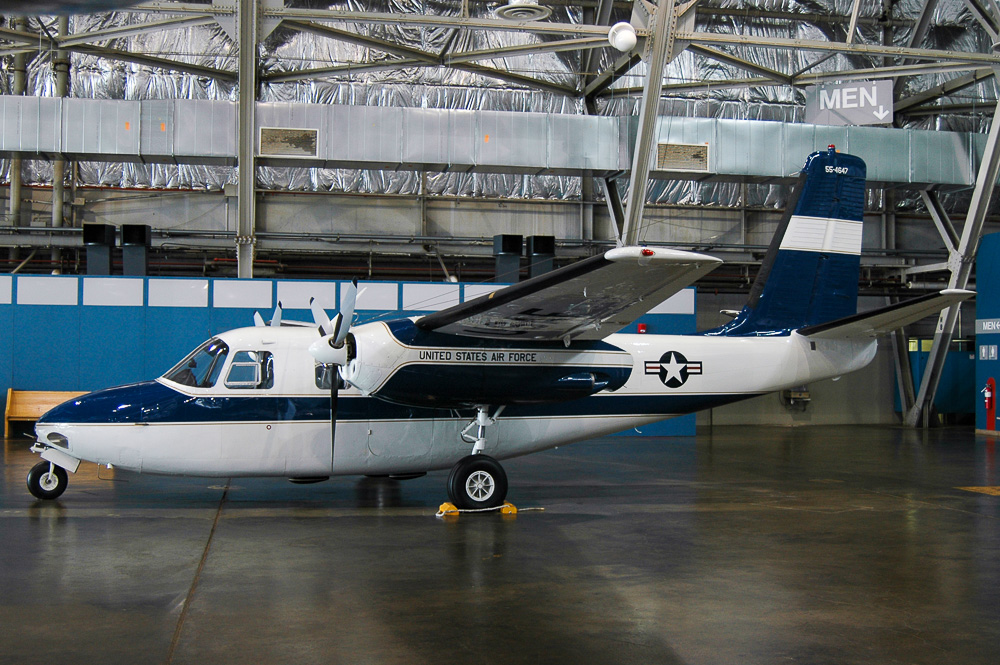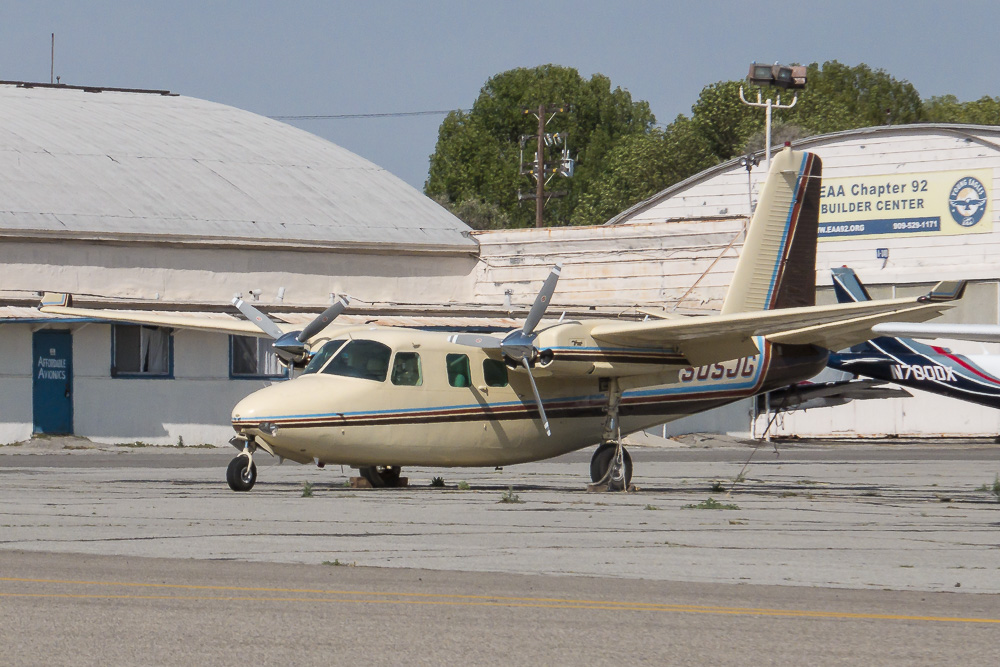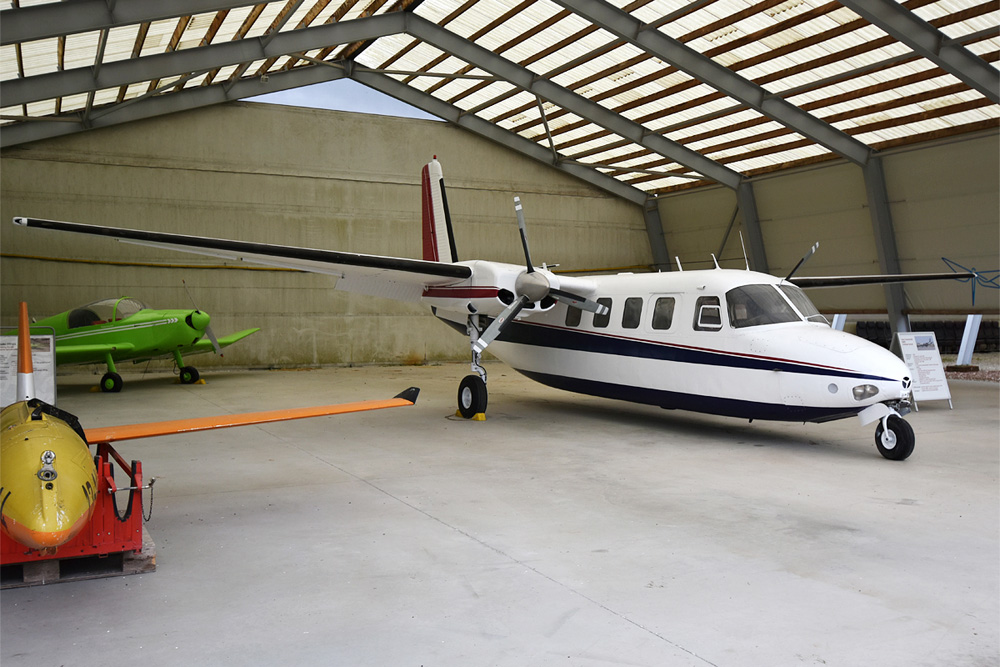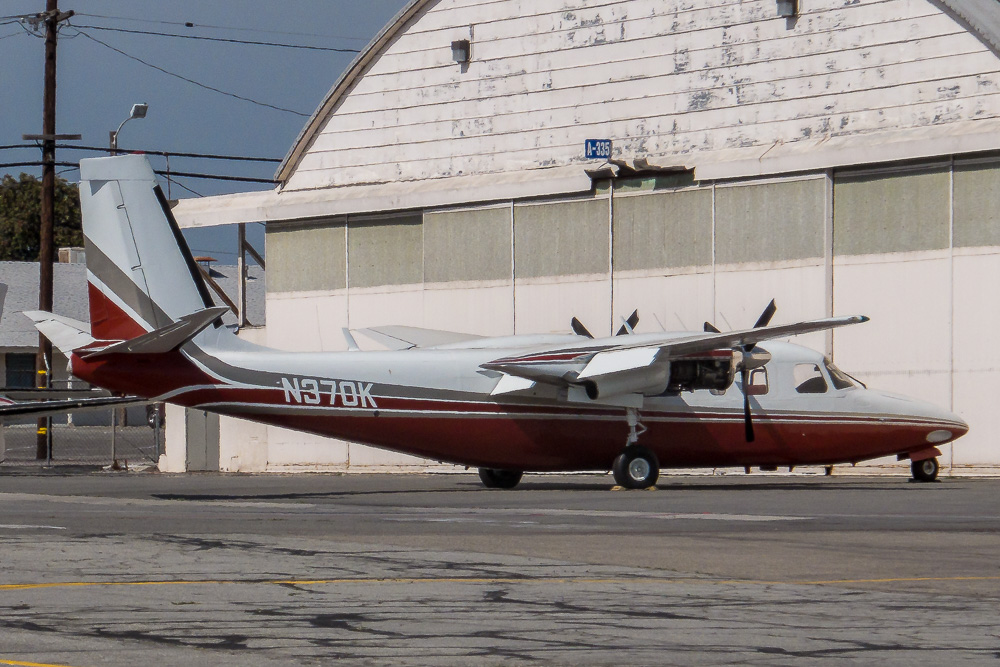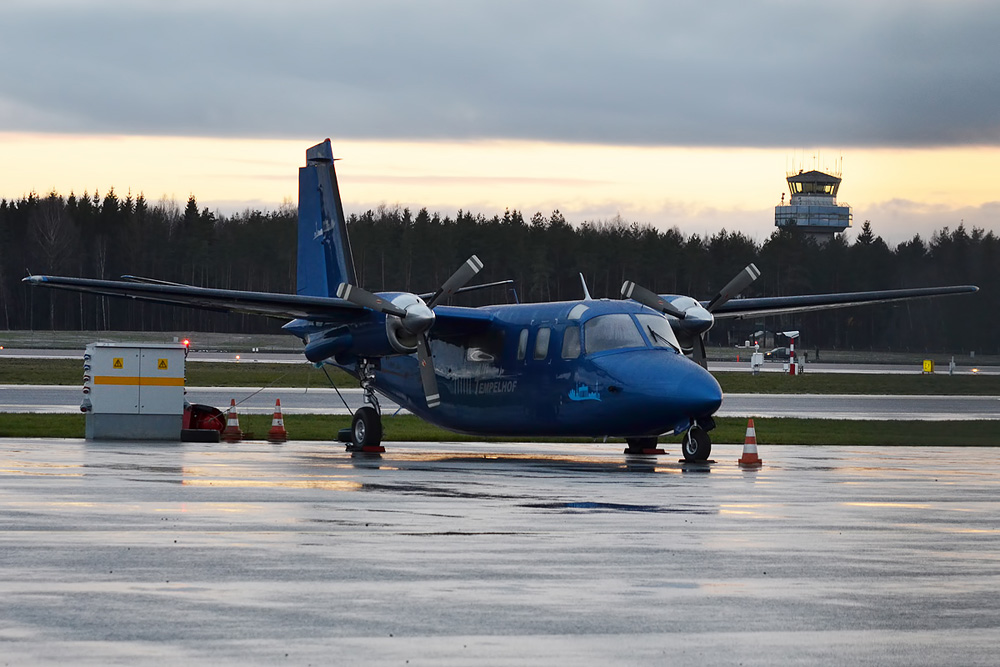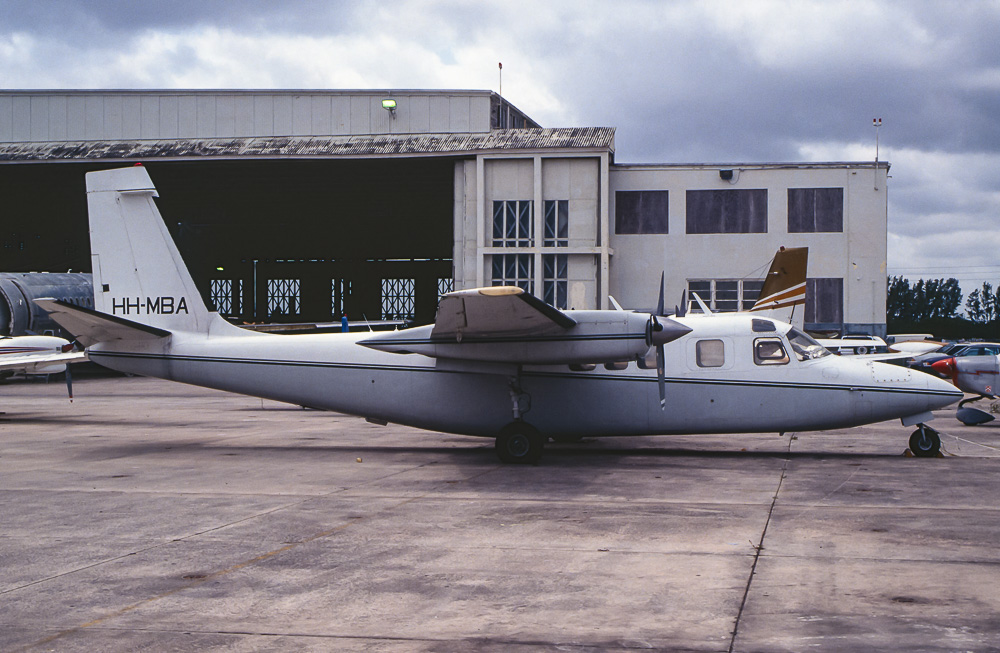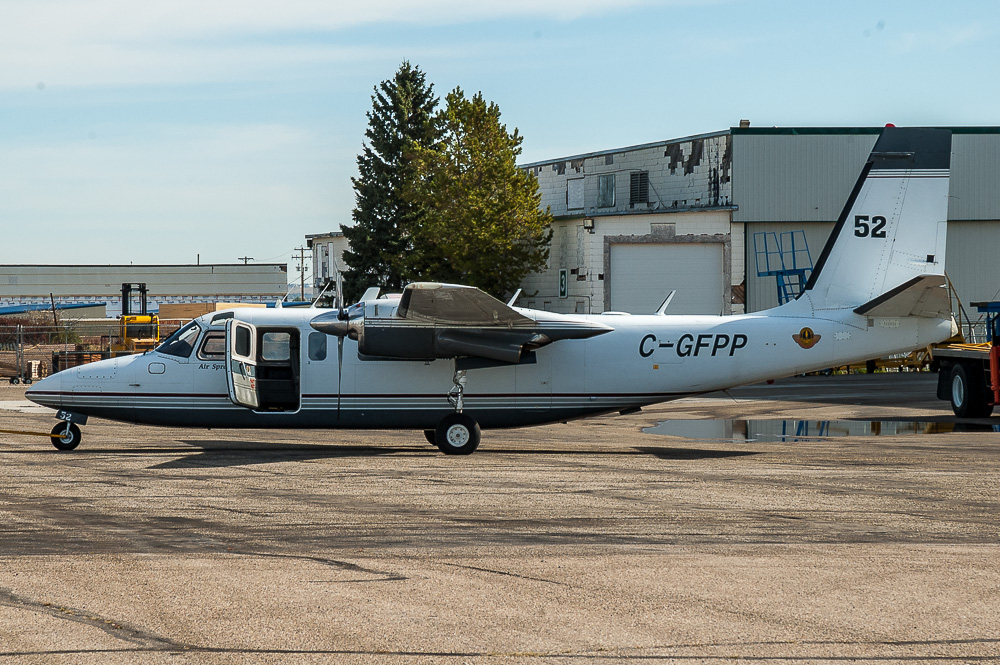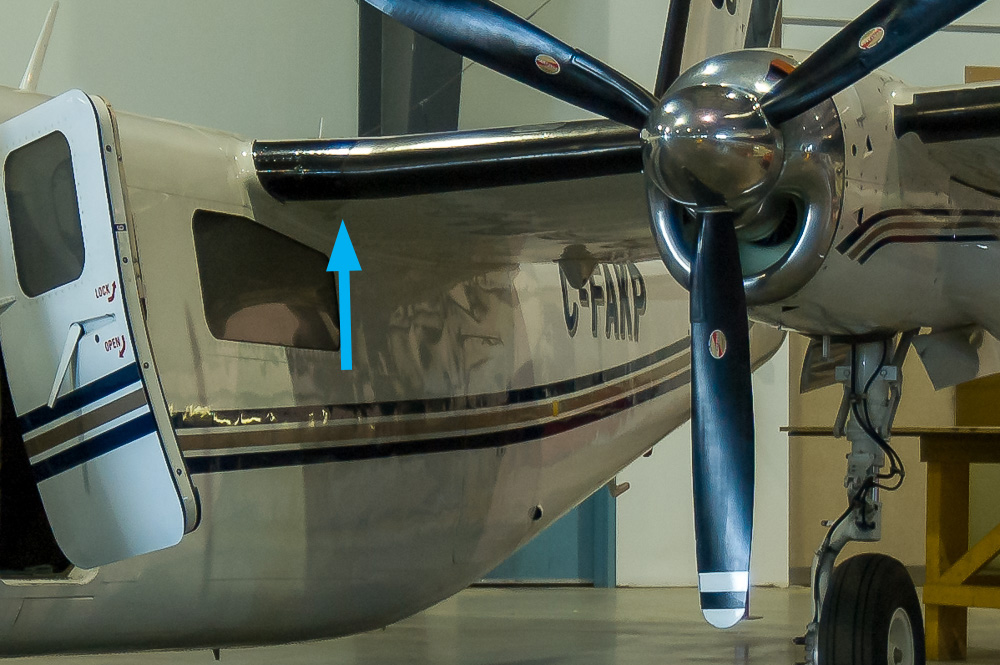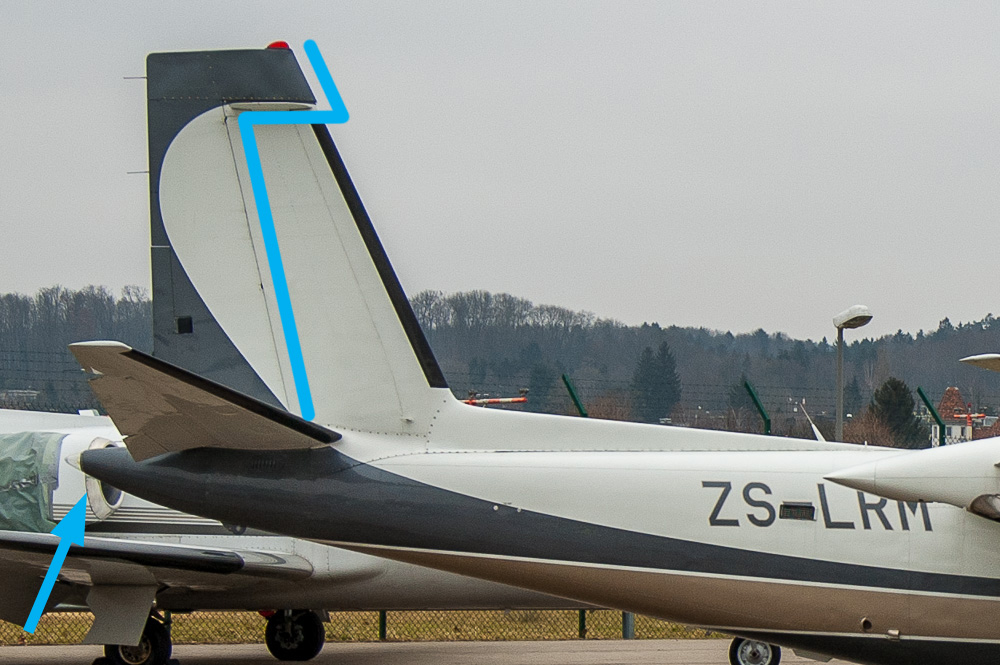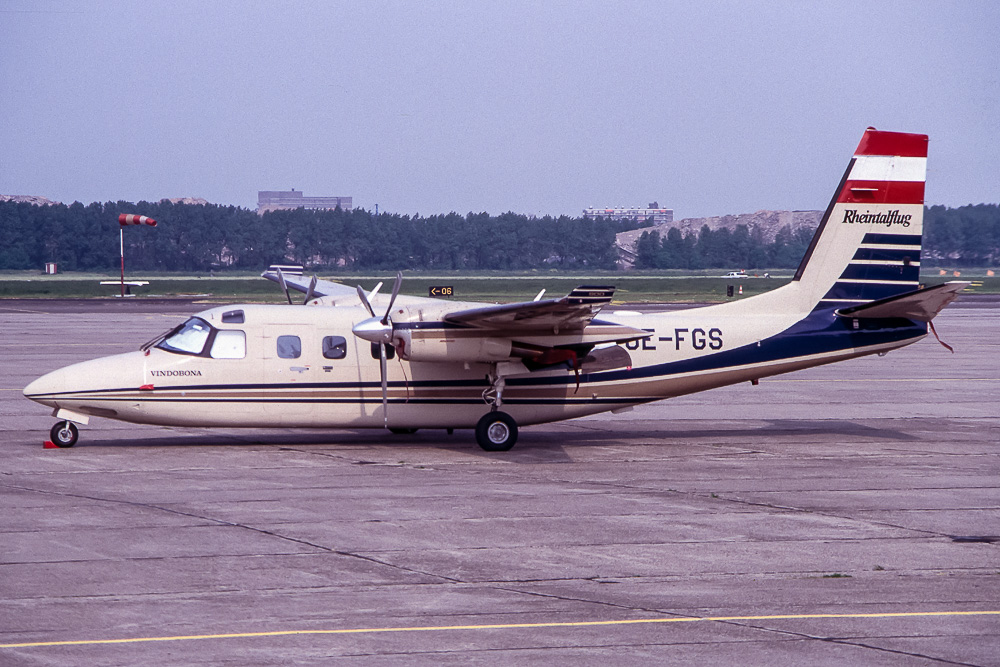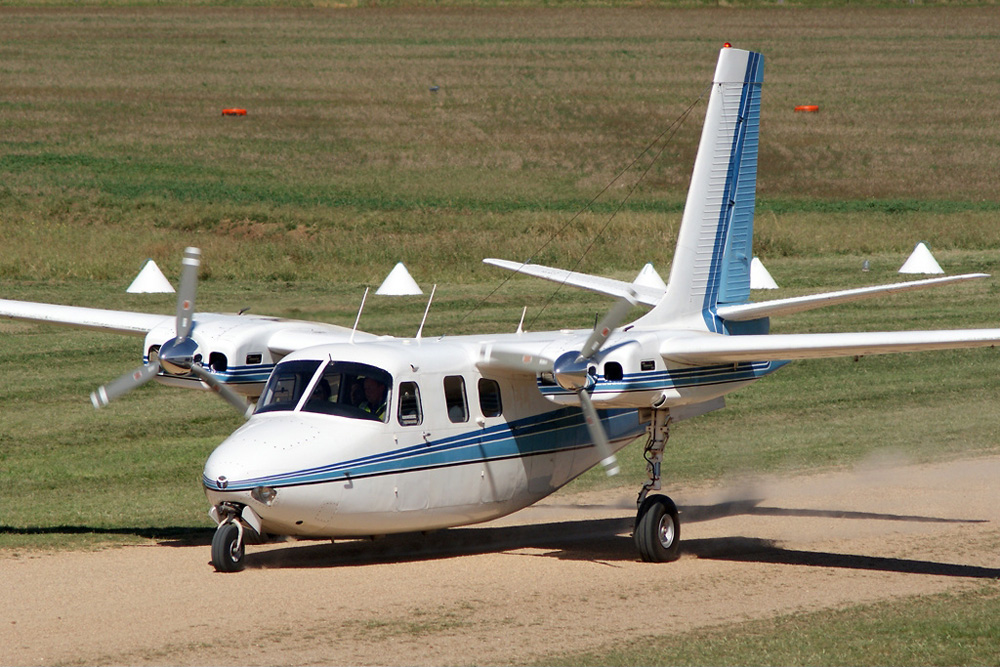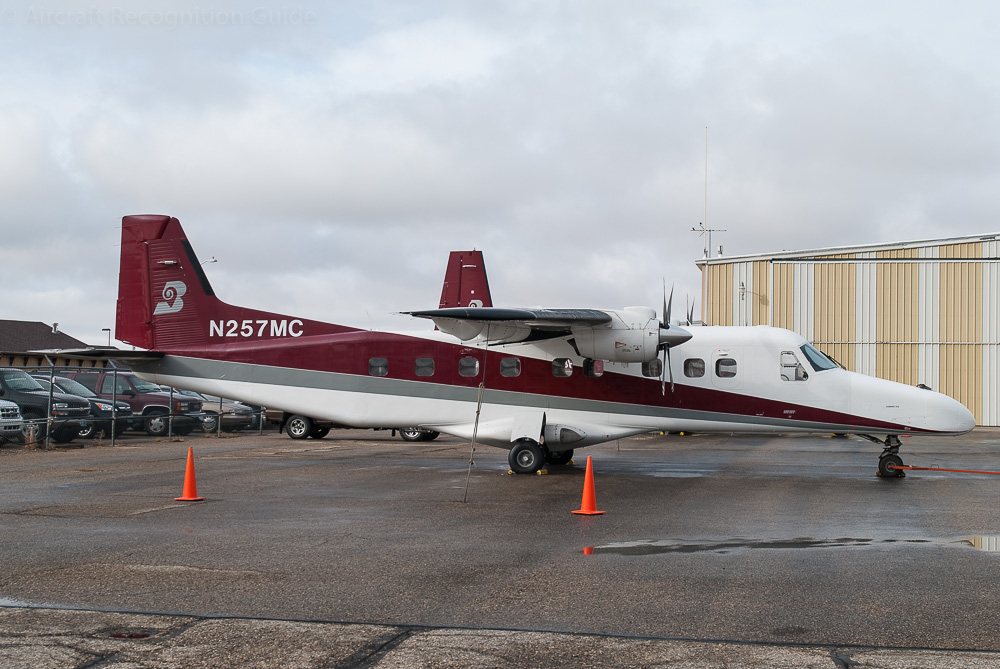
Rockwell/Gulfstream (Aero Commander) Twin Commander series
This family of twin piston and turboprop private/corporate aircraft originates from the late 1940s. Then it was one of the first of such modern aircraft, together with the Beechcraft Twin Bonanza. The Aero Design & Engineering Company designed a new aircraft inspired by the Douglas A-20 bomber. Eventually the renamed company Aero Commander put the aircraft into production, which lasted well into the 1980 with a far family member.
The Twin Commander, as the family is generally referred to, has straight wings placed on top of the rounded rectangular cross section fuselage. The empenage is conventional, with the horizontal stabilisers having a small dihedral. The landing gears all have a single wheel. The main gear retracts backward in the nacelles. The nose gear is short and close the tip of the nose. The length of the gear keeps the fuselage just off the ground, very typical for the family.
From this angle you can clearly see that the fuselage of the Twin Commander family is just a feet from the ground, thanks you the short (nose) landing gear.
Different versions
The different versions of the Twin Commander family can be identified by looking at:
- the shape of the engine nacelles
- the size of the wing span between the nacelles and fuselage
- the size of the wing span outside the ailerons
- the shape of the nose
- the shape of the vertical stabiliser
- the shape of the rudder
- the shape and number of cabin windows
- the presence and shape of small/low winglets
- the shape of the dorsal fin
- the shape of the tail cone
- the number of propeller blades
- the shape of the cockpit windows
- the number and location of cooler intakes at the front of the nacelle
- the presence of an air intake on top of the fuselage
Details will follow later.
L3805
The whole Twin Commander family is derived from this purpose-built private/executive aircraft based on the Douglas A-20 Havoc bomber. This was because Ted Smith, the designer of the L3805, was an engineer at Douglas before starting his own company and had experience with the A-20. It has the basic Twin Commander configuration with a straight vertical stabiliser. Unlike later models it has a forward retracting nose gear, long cockpit side windows and a fuselage that starts to slope up already from the wing leading edge.
The Aero Design L3805 was the starting point for the whole Twin Commander line. It has a straight vertical fin like the Commander 520, but with a more tapered rear fuselage and longer cockpit side windows.
Model 500
This is a Commander 560E with less powerful engines and reduced weight. This is not visible from the outside, even though these engines are of a non-geared type. They power two blade propellers however, thus it is the only model with thick 'bathtub' type nacelles with such props. All others have three blade props. Finally, the Commander 500 has the landing gear of the model 560A.
The Commander 500 is the only one with big nacelles and two blade props.
Model 500A
The Commander 500A is basically a Model 500 with new, slimmer 'Speedline' engine nacelles. These extend after the wings, ending flattened, and have exhausts at the top. Due to the slimmer nacelles, the gear was modified: it rotates ninety degrees when being retracted rearward. Also new are main landing gear doors. The Model 500A retains the two-blade props of the 500.
The Model 500A is similar to the Commander 500, but has slimmer engine nacelles, ending flat. Note the two blade props and cooler intakes at the sides of the spinner.
Model 500B
The Commander 500B is essentially the same as the Commander 500A, but with more powerful engines and three blade propellers. The nacelle has two cooling intakes at the lower part, on each side of the spinner. This model is difficult to recognise from the Commander 500U and early versions of the 500S, except that the early 500Bs had corrugated, or beaded control surfaces. Later aircraft have smooth horizontal and vertical stabilisers.
Many Commander 500Bs have been converted with a long and pointed so-called Miller nose and squared top of vertical stabiliser, making them look like a Commander 500S. Some also have winglets and/or eyebrow cockpit windows.
A Commander 500B with only a squared vertical stabiliser as modification. Note the three blade props with two cooling intakes left and right below the spinner, and the corrugated surface of the vertical fin.
This Model 500B is more heavily modified: sqaured vertical stabiliser, winglets, long Miller nose and eyebrow windows. The tail is still corrugated though.
Model 500S Shrike Commander
The Commander 500S was at first the same as the 500U, with as only external difference the standard cockpit entry door. Other difference were inside only. Later during the production run the longer, pointed nose became standard, as was the squared top of the vertical stabiliser. As earlier models, including the 500B and 500U, can be modified with these changes as well, they are no definitive recognition points, unfortunately.
Shrike Commander was the new marketing name Models 500S and 500U after the take-over of Aero Commander by Rockwell.
N77VF is an example of how the later Model 500Ss looked: the a long, pointed nose, cockpit eyebrow windows and a squared vertical stabiliser. These are available as a modification on older models as well though...
Model 500U Shrike Commander
Essentially, the Model 500U is a Model 500B with the stronger wings of the Model 680FL. Externally, the 500B and 500U are the same though, except that all Commander 500Us have smooth control surfaces, like the late model 500Bs, unlike the early 500Bs with corrugated surfaces.
After the take-over by Rockwell the Model 500U received the new marketing name Shrike Commander, like the 500S.
Many Commander 500Us have been converted with the longer more pointed "Miller" nose, eyebrow cockpit windows, winglets and squared tip of the vertical fin.
A Commander 500U.
Model 520
This is the production version of the original L3805 proof-of-concept aircraft. Compared to that aircraft it has a longer fuselage that starts to taper later, a less rounded front with cockpit windows not flush with the nose and smaller cockpit side windows. The cabin has two smaller windows instead of one long big one. Finally, it has a straight, unswept vertical tail with a slight trapezium shape.
There are some variants of Model 520. Early versions have a less tall vertical stabiliser, long nose gear doors and two blade props. Later the fin became taller, the gear doors smaller and three balde props were used.
The US Army was an early customer for the Model 520 with designation YL-26, later YU-9.
This preserved YL-26 is the military version of the Commander 520. Note the unswept vertical stabiliser, typical for this model.
Model 560
With the introduction of the Model 560, the type has a slightly swept vertical tail, which Model 520 does not have. For the rest it is the same as late model 520s: small nose gear doors, three blade propellers and wide diameter nacelles (so-called 'bathtub' types) with the long exhaust visible along the lower side of it. The main gear has torque links, or scissors, facing aft. Finally, the first cabin window has a rectangular shape.
The US Army designations fo the Commander 560 are YL-26A and from 1962 YU-9A.
The Commander 560 can be recognised by the slightly swept tail, long external exhaust pipes along the thick nacelles and rectangular first cabin window.
Model 560A, 560A(HC) & 680
Compared to Commander 560 the fuselage of the Model 560A is 10 inches longer. This is not very visible, except for the square instead of rectangular first (centre) cabin window. Externally better visible is that the exhaust pipe of the 560As is almost completely inside the nacelle. Also the main landing gear has the torque links facing forward.
560A(HC) was the manufacturers designation for the Model 560A with different engines, with High Compression.
This model was used by the US military. Until 1962 it was designated L-26A, and after that U-4A (USAF) and U-9B (US Army).
Model 680 is a Commander 560A with different, supercharged engines, but this is not visible from the outside. It is sometimes referred to as "Super".
The USAF designations for Model 680 are L-26C and U-4B. RL-26D/RU-9D was the name for an electronic reconnaissance version, with a larger nose radome and SLAR equipment along the fuselage.
Here is a photo of a Commander 680. As you can see it is indistinguishable from the Model 560A.
Model 560E & 680E
Model 560E was a replacement for Model 560A with as main difference a 32 inch addition to the wingtips (on each side). Hence Commander 560E can be recognised from the Commander 560A by looking at the wingtips: the ailerons do not extend fully to the tips. The version is also supposed to have the main landing gear at a different location, but how is not known, or at least not clearly visible.
Basically, the Commander 680E is a Model 680 with a larger wingspan. Like on the 560E 32 inches are added on each side, outside the ailerons. As the 560A and 680 cannot be distinguished externally, the same applies to the 560E and 680E.
The difference between this Commander 680E and the 680 are the extended wingtips, outside the ailerons. Note that the two blade props are not standard.
Model 560F & 680F
The Model 560F is a Model 680F with reduced weight and non-turbocharged engine. Externally, both models are the same. So the Commander 560F has slim engines nacelles with exhaust on top. These nacelles have three cooling intakes at the front. The main gear rotates ninety degrees when retracted rearward in the nacelles. The wings are of the extended version, like on the Model 560E and 680E.
Models 560F and 680F both have slimmer engine nacelles with three cooling intakes at the front. This is a Commander 680F, with small winglets as modification.
Model 680F(P)
Aero Commander offered an optional pressurisation package for the Model 680F, designated 680F(P). It has the air intake for the pressuration system on top of the fuselage, in between the trailing edges of the wings.
The air intake for the pressuration system of the Commander 680F(P) is visible on top of the fuselage, in between the wings.
Model 680FL Grand/Courser Commander
The first long fuselage Commander was the 680FL, named Grand Commander and later Courser Commander. It is a stretched version of 680F with four square cabin windows on each side, of which the one in the cabin door on the left is smaller than the rest of the early production version. The cockpit side windows have a storm window inside of it. The front edge is the same as the frame between the front and side windows.
Some were equipped with double entry doors, known as Courser Liner Commanders. An after market conversion is the replacement of two cabin windows with a large panoramic window. Also the second cabin window is now smaller and rectangular.
Here is an original Model 680FL, with four square cabin windows. Note the "storm" windows inside the cockpit side window, surrounded on three sides by the outer window. (photo: Anna Zvereva/WikiMedia)
If you look closely, you can see the panoramic cabin windows just below the nacelle. Also the second cabin window is rectangular on this modified Commander 680FL. (photo: Peter Bakema/WikiMedia)
Model 680FLP
The pressurised version of the Model 680FL has an air intake of the pressurisation system on top of the fuselage, just behind the wings. Additionally, the storm window inside the cockpit side windows is completely surrounded by the outer window.
The Model 680FLP has a pressuration inlet on top of the fuselage. Note the cockpit side window with completely surrounded storm window.
Model 680T Turbo Commander
The turbine Commander line started with equipping Model 680FLP with TPE331 turboprops. Soon the model was improved by removing the 32 inch wing extensions, changing the scooping intake for the pressuration for a flush one, squaring the top of the vertical stabiliser and more non-visible changes. For the rest it retains the (standard) four square cabin windows and short nose. Some aircraft had streamline caps around the main gear and/ora radar in a small bulge on top of the nose.
Only a few Model 680T Turbo Commanders remained original: with a short nose and four square cabin windows. Most were converted to 680V.
Model 680V Turbo Commander
Many Model 680Ts were later converted to Model 680V, that also had the name Turbo Commander. The most prominent chages were the addition of panoramic cabin windows instead of the aft two square cabin windows, and making the second square window smaller. Also the 680V has a longer, pointed nose with flush landing lights as standard. As the panoramic windows are used on the 690 models as well, you have to keep them apart by looking at the diameter of the props and distance between fuselage and engines. The propeller of the 680V have a smaller diameter due to the (orignally) smaller distance between the fuselage and the nacelles.
Compare the diameter of the props of this Model 680V with those of the Model 690 below and you'll see they are smaller. Below the nacelles the underside of the panoramic window is visible, distinguishing it from a Model 680T, as is the pointed nose.
Model 680W Turbo II Commander
Basically Model 680W is a RC680V with different engines and higher operating weights. Externally, the most visible change is the removal of the landing lights from the pointed nose. These have been replaced by retractable ones in the wings. However, later modifications may have them returned to the nose, so you cannot completely depend on it.
Small diameter propellers, no landing lights in the nose and no eyebrow cockpit windows, so this should be a Model 680W Turbo II Commander. (photo Cdanielsiv/WikiMedia)
Model 681 & 681B Hawk Commander
The Hawk Commander was the last with the orignal wing centre section, so with small diameter propellers. It is a Model 680W with overhead "eyebrow" cockpit windows as standard, although these are available as retrofit on older models as well. Model 681B was used for the remaning aircraft on the production line that had to be sold quickly to make room for the new Model 690.
From this angle you can clearly see the small diameter props that makes it possible to recognise this Model 681 Hawk Commander from later models. The eyebrow cockpit window is the key feature of the 681 compared to the 680W. (photo: Anna Zvereva/WikiMedia)
Model 685
This is the only piston powered Twin Commander with the increased span of the wing centre section as found on Model 690 and on. See description below. Hence it can be recognised by the larger distance between fuselage and engines compared to other piston powered Commanders. The Model 685 als has the eyebrow cockpit windows and horn balanced rudder of the 690, but a different arrangement of cabin windows. It has four square windows with more space between the front two windows than the others. The space is in the plane of the prop, which is placed further to the front of the aircraft than on the turbine powered versions.
The Model 685 is basically a Model 690 with piston engines. However, it has no large panoramic cabin window but four smaller ones. There is a large space between the front two windows, where the prop turns.
Model 690
Starting with Model 690 the Twin Commander received a new, wider wing centre section, which places the engine nacelles 15 inches further from fuselage than previous models. Therefore the props have a significantly larger diameter than those of the 681. Another significant external change is that the rudder extends all the way to the top of the vertical stabiliser. The whole tip of the fin moves with the rudder, as the front part acts as balance. Finally, the rudder trim tab is taller but with a smaller chord width than previous ones. For the rest the tail stays the same, so a short dorsal fin and tail cone. These are characteristics to distinguish the 690 from later versions.
MT Props has an STC to equip Twin Commander models 690, 690A, 690B, 690C, 690D, 695, 695A and 695B with five blade composite propellers. There is no difference in designation though.
A full view of a Model 690 Turbo Commander, with the short curved dorsal fin and short tail cone. For the key features of the 690 compared to earlier models see the next photo for the wings and props and below at the 690A for the tail.
When viewed from the front you can clearly see the added section to the wings, with smaller diahedral than the rest of the wings. Also the larger diameter of the propellers is evident, especially compared to the ones of the Model 681 above.
Model 690A & 690B
The external differences between the Models 690 and 690A are cosmetical. Added were a long, narrow dorsal fin and a more pointed tail cone.
Model 690B is very similar to the 690A, although the dorsal fin is supposed to be non-truncated at the front, but flush with the fuselage. So far, we failed to notice that. The pointed tailcone was only used up to c/n 11540.
The Model 690A Turbo Commander has a long dorsal fin and pointed tail cone, although the former is a bit obscured. Well visible is the shape of the rudder, as the rudder is pushed to the side.
On this detail photo you can better see the long dorsal fin and pointed tail cone that distinguish the Commander 690A from the 690. Also highlighted is the shape of the rudder, including the horn balance at the top.
Model 690C Commander JetProp 840 & Model 695 Commander JetProp 980
The longer wings of piston Commanders like the 560E and 680E were first used on Models 690C and 695. The 690C has a 30 inch extension on both tips, ending in a small canted winglet. These winglets are less wide than the ones placed on older models as a retrofit. That makes identification easier. Also the dorsal fin is nearly gone on the early 690Cs, to be replaced later during the production run by one starting higher on the leading edge and ending earlier than on the 690A/B. The final extern change is the location of landing lights in the nose, like on the original long nose Commanders. The marketing name of this version was Commander JetProp 840, referring to the amount of horse power produced by the engines.
The Commander JetProp 980 is nothing more than an 840 with more powerful engines, so externally there is no difference. Model 695 also had no dorsal fin at the start of the production, and the same as the 690C later during the production.
During the first years of the production run the Modle 690C had no dorsal fin. Other features were present tough, including the wing tip extensions with small canted winglets. Note that these are smaller than those on the 690A shown above, due to the smaller wing chord.
Here is a later production version of the Commander JetProp 840, with again a dorsal fin, although different from previous models.
Model 690D Commander JetProp 900, Model 695A Commander JetProp 1000 & Model 695B Commander Jetprop 1000B/Commander 1200
Internally, Model 690D (or Commander JetProp 900) is totally different from the 690C. The structure has been changed to allow the whole fuselage to be pressurised, and also to a higher differential. This was not possible with the characteristic panoramic cabin windows, so these have been replaced by three nearly square windows. That is thus the main external difference.
Model 695A is the higher power version of the 690D, marketed as Commander JetProp 1000.
The final Twin Commander production version was the Model 695B, that has even more powerfull engines and higher operating weights than the 695A. Externally they are the same tough. The Commander 1200 was a development of the Model 695B with different engines and four blade props. It was never put into series production.
Although the cabin windows are partially hidden behind the nacelle, you can well see the larger size of the second window of the Modle 690D compared to the Model 690C/695.
Three of the four cabin windows are visible on this early production Commander JetProp 1000, judged by the absence of a dorsal fin.
Model 720 Alti Cruiser
This model was the first Twin Commander with pressuration. It is based on the Commander 680, so with the old 'bathtub' shaped nacelles. Additionally, Model 720 has the extended wing of Model 680E. The air intake for the pressuration system is on top of the fuselage, in between the wings.
Too bad this Model 720 Alti Cruiser has been dismantled because you cannot see the engine nacelles. But at least you can clearly see the scooping air intake for the pressurisation system in between the wings. (photo Aeroprints/WikiMedia)
Model 800
Only two prototypes of the Model 800 were made. These were a Model 500S with a circular cross section of the fuselage, higher placed wing and the nose of the Model 680W.
The Commander 800 was a unique Twin Commander with its circular fuselage.
Century Turbo, Dash 10 Commander & Grand Renaissance Commander
These are all engine upgrades of the Turbo Commander series, all with other versions of the TPE331 engine. Additionally, with the Grand Renaissance Commander treatment, the whole airframe is refurbished, making it as good as new. hence Renaissance. Externally, there are no changes compared to the original models, except maybe for stickers highlighting the upgrade.
Colemill Super 300
This is a modification of the Model 500A with different, more powerfull engines and three blade propellers. It retains the two cooler intakes at the sides of the prop spinner.
This Commander 500A has been converted to a Colemill Super 300, and now has three blade props. It still has cooler intakes at the sides of the prop spinner though. (photo Phil Vabre/WikiMedia)
Confusion possible with
Mitsubshi MU-2
The MU-2 is of similar size as the Twin Commander and also has high wings and a conventional tail, but the horizontal stabilisers have no dihedral. The main gear of the MU-2 retracts in the fuselage though. The nose gear has two wheels. Finally, nearly all MU-2s have tip tanks.
Britten-Norman BN-2
Another type is of similar size and configuration is the BN-2 Islander. Its double wheel main landing gear is fixed though, being attached to the wings with long struts. The wings are have a wide chord, all the way to the tips. Additionally, the horizontal stabilisers have no dihedral. Finally, the cabin windows are larger.
Vulcanair AP68TP Viator/A-Viator

This aircraft has an all single wheel retractable gear, attached to stubs under the fuselage, and a long nose to house the nose gear. For the rest it is quite similar to the Twin Commander series.
Tecnam P2012 Traveller
This aircraft can be seen as a more modern version of the Islander. The P2012 also has a fixed main gear but attached to the fuselage and small cabin windows with 'race track' shape. (photo by Marco Papa, used with permission)
Dornier 228
While the Do228 is significantly larger than the Twin Commander, its cabin and cockpit windows may cause a mixup. The Dornier has a less tall tail, smaller nacelles, a main landing gear retracting in the fuselage and pointed wingtips.
Let L-410
The Twin Commander family is smaller than the L-410 and also has high wings, a tall vertical stabiliser and horizontal stabilisers with dihedral. This stabilo is placed higher though of the Let. Also, the main gear of the Twin Commander retracts rearward in the nacelles.





